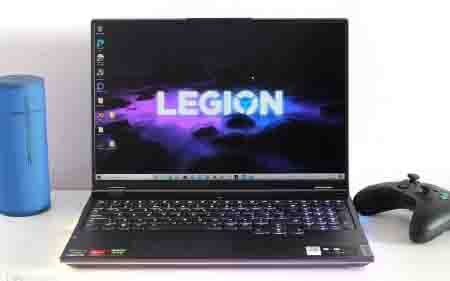Lenovo Legion 7 laptop review: there must be silence!
 01 / 04 / 22
Visitors: 509
01 / 04 / 22
Visitors: 509
Over the past few years, we have visited several models of Lenovo laptops. The company has apparently found a balance for itself, in which it is possible to install components of absolutely different levels in the same chassis. Without radically changing the components of the cooling system and the geometry of the case, the company saves. And it turns out devices, respectively, of a basic or productive level for different user groups.
Whether it’s good or bad, it’s hard to say for sure, but the devices fulfill their task, and our feeling of deja vu can be pressed down for a while and surrender to the content. Games, working with content, sitting in boarding schools and other things that are not so strong and depend on the design of the case.
Design
The Lenovo Legion of recent years are devices that remind us of hatchbacks from the automotive world. They can be gray in color, with inexpressive body shapes, with an unpretentious body design and, by and large, boring. But you can do chip tuning, insert RGB lighting, stick a couple of stickers and you get a “hot” hatchback. Something like this is done by automakers and this is how we see Lenovo Legion 7.
If you turn on the power saving mode, choose a single-color keyboard backlight, turn off the glow from the ventilation grilles, and put on a corporate desktop wallpaper, the Legion 7 can easily be confused with the workhorse of every day.
It uses predominantly gray panels. All of them are straight, forming parallelepipeds or trapezoidal shapes. This applies to both the base with the filling and the lid with a screen. In the edges, beveled at an angle, LED backlight was installed, and in the lid a block with a webcam and face recognition and presence sensors is issued from it.
Air outlet grilles are installed in the part of the sidewalls farthest from the user, as well as on the back side. So hot streams touch the user to a minimum. In this model, they are also decorated with lighting, and it intriguingly flows from them, illuminating the space around the laptop. Part of the Legion logo on the lid also glows.
The keyboard also has multi-colored backlighting. It is configured through the Corsair iCUE RGB app.
Of the other software goodies, the laptop has support for Tobii technology. Earlier we talked about its work in one of the monitor tests. Here it allows you to automatically monitor whether the owner is sitting at the laptop. Dims the screen if it has moved away, and/or locks it on a timer. Some games also support the technology, allowing you to turn your head to control a character or camera.
In terms of interfaces, there is everything for both work and night rides. On the sides are high-speed USB Type-C ports. On the left, this port is complemented by an audio jack, and on the right, a digital switch for the webcam shutter.
All major ports are located on the back. Among them are USB Type-A, and Ethernet, and full-sized HDMI. This arrangement is a great solution so that the connectors and wires do not get tangled at hand.
Remember we're talking about a 3080 laptop? Therefore, at the base, the cover has a wide air intake strip and rather high legs. Also visible on the sides are mesh Harman speakers with support for Nahimic audio tuning technologies.
Equipment
Let's compare the Legion 7 model with a representative of the lower class - Legion 5. It is curious that not only in design, but also in technical terms, they are largely similar.
So, the matrices of their displays are the same. Installed IPS, a resolution of 2560x1600, a diagonal of 16 inches. The resulting ratio of 16:10 allows you to feel less constrained in content editors - you can more comfortably place timelines and toolboxes from below.
The matrix has a refresh rate of 165 Hz, and, accordingly, support for NVIDIA G-Sync. 100% sRGB is displayed, and the display is VESA DIsplayHDR 400 certified. So color reproduction and image smoothness are in order.
Legion 7 and 5 have an identical set of ports and drives. Up to 2 SSDs with a total capacity of 2 TB are installed. In this case, these are two WDC PC SN730 SDBPNTY-1T00. Optionally, the Legion 7 may have a Killer Wi-Fi AX1650 (2x2) adapter.
AMD versions differ in that Legion 7 can get Ryzen 9 5900H in the top, and Legion 7 can get Ryzen 7 5800H. Which in this case turned out to be in our sample. This is one of the most suitable options for mid-range gaming laptops. The chip architecture includes eight cores operating at a nominal frequency of 3.2 GHz and up to 4.44 GHz in dynamic overclocking mode. For graphics processing, the Ryzen 7 5800H processor has an integrated AMD Radeon RX Vega 8 graphics core.
Legion 7 comes with up to 32 GB of RAM, while Legion 5 comes with up to 16 GB of RAM.
Another notable difference is that Legion 7 can have an NVIDIA GeForce RTX 3080 at its max version, while Legion 5 can have an RTX 3070.
Let's describe what has changed. By and large, the 3080 is the same “hot” video card as the 3070. By and large, the 3080 is just as hot as the 3070. If the 3070 was 140W, the 3080 is already 165W, including 15W in performance mode. The obtained measurements roughly correspond to this increase - within the limits of up to 10%.
When working with light tasks, everything is quiet. The minimum speed is enough for the system, which are practically inaudible to the user.
More noticeable noise appears a little earlier than at 30-40% of the load. The system “swells up with a margin” and a little earlier than the load with the test package becomes stable.
Of course, during prolonged operation at full load, at 98-100%, the video card requires active air removal. We managed to warm it up to 88-92 ° C with a long maximum load and a high number of frames. At the same time, the system makes a noticeable noise, but this cannot be avoided. The case also noticeably heats up as it gets closer to its installation site. At the bottom corners under the keyboard, the surface is just warm.
However, it is worth noting that even at maximum speed, the laptop is noticeably quieter than models with the same video card. On the one hand, this has a much more favorable effect on comfort, on the other hand, you involuntarily worry about overheating. However, even during long stress tests, the system worked correctly, managing to drop critical degrees.
Impression
In general, Lenovo Legion 7 turned out to be a tuned version of the previously reviewed models of the Legion 5 line. Being quite strict and concise in design, it has gaming accents - multi-colored backlighting of the keyboard, ventilation and logo.
Improvements inside are much more noticeable - the chassis still allows you to install powerful models of video cards with a high TGP. Yes, this affects the noise and forces you to make the sound louder or wear headphones. But performance does not suffer and its level is maintained under prolonged loads. Of the noticeable manifestations - a strong heating of the case.
In an effort to make the case more compact, and it is such, taking into account the installed 3080, there is no escape from power needs. When planning to take a laptop with you, do not forget about the 300-W power supply, which is a quarter of the entire laptop in terms of volume. Yes, and it weighs 800 g. However, if a video card is not needed, it will be possible to power the system via USB with Power Delivery support.
It is believed that Lenovo Legion 7 is already the limit of the power-comfort balance. There is also no certainty that models with Ryzen 9 or Core i9, which also exist, will be optimal and you will not want to change them to something quieter.
A complete list of unscrupulous brokers, that we do not recommend working with is available here.







